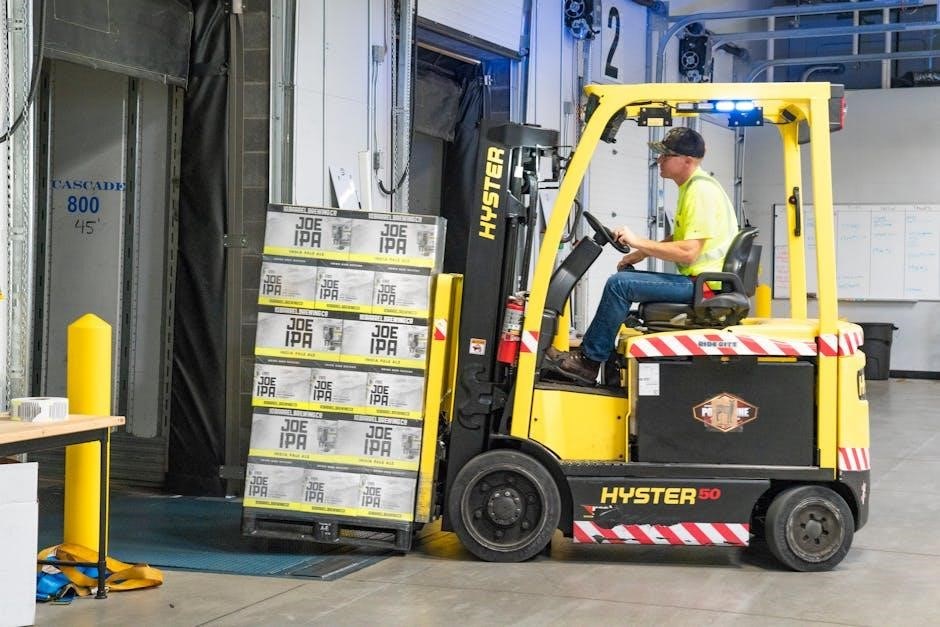The Ohio Commercial Driver License Manual is a comprehensive guide for aspiring CDL holders, detailing requirements, tests, and safety practices. It ensures drivers are well-prepared for the 50-question general knowledge exam, which requires an 80% passing score to obtain a learner’s permit, essential for legal CDL training under supervision.
Overview of the CDL Manual
The Ohio Commercial Driver License Manual is an essential resource for those seeking a CDL, providing detailed information on licensing requirements, testing procedures, and safety standards. It covers topics such as vehicle inspections, traffic laws, and endorsements, ensuring drivers understand their responsibilities. The manual is structured to guide applicants through the licensing process, from eligibility criteria to the skills test. It also emphasizes safe driving practices and regulatory compliance, making it a critical tool for both new and experienced drivers. By following the manual, applicants can effectively prepare for exams and operate commercial vehicles safely and legally in Ohio.
Importance of the CDL Manual for Drivers
The Ohio Commercial Driver License Manual is essential for drivers seeking to obtain or renew their CDL. It provides detailed information on state-specific regulations, safety practices, and exam preparation. The manual ensures drivers understand the 50-question general knowledge test and the 80% passing requirement, which is critical for securing a learner’s permit. By studying the manual, drivers gain insights into vehicle inspection procedures, on-road safety, and compliance with federal and state laws. This knowledge not only helps drivers pass required tests but also promotes safe and responsible driving practices, reducing risks on the road for themselves and others.

Types of Commercial Driver Licenses (CDLs) in Ohio
Ohio offers Class A, B, and C CDLs, each catering to different vehicle types and cargo requirements, ensuring drivers are licensed for their specific profession.
Class A CDL
A Class A CDL in Ohio is required to operate combination vehicles with a trailer in excess of 10,001 pounds, such as tractor-trailers. This license allows drivers to haul heavy loads across long distances and is ideal for careers in long-haul trucking. To qualify, applicants must be at least 21 years old and pass specialized tests. The Class A CDL is the most comprehensive, offering the broadest range of driving opportunities. It is essential for those aiming to work in industries like freight transport or oversized load hauling. Proper training and adherence to safety protocols are critical for success in this category;
Class B CDL
A Class B CDL in Ohio allows drivers to operate heavy straight trucks, buses, and other large vehicles with a gross vehicle weight rating (GVWR) of 26,001 or more pounds. Unlike Class A, it does not require towing a trailer. This license is ideal for drivers transporting goods locally or working in construction, public transit, or waste management. To qualify, applicants must pass specific skills tests and meet medical requirements. Additional endorsements may be needed for transporting passengers or hazardous materials. The Class B CDL is a versatile option for those seeking employment in industries requiring heavy vehicle operation.
Class C CDL
A Class C CDL is required for operating small passenger vehicles or hazardous material transports. It covers vehicles not falling under Class A or B, such as buses or Hazmat vehicles. Unlike Class A, it does not involve combination vehicles with a trailer. Drivers must pass specific tests and endorsements for specialized cargo, ensuring safety and compliance with regulations. This license is ideal for those transporting passengers or handling dangerous materials, requiring additional certifications beyond the general CDL.

Eligibility Criteria for Obtaining a CDL in Ohio
To obtain a CDL in Ohio, applicants must meet specific eligibility criteria, including being at least 18 years old, providing proof of residency, passing a medical examination, and completing background checks. These requirements ensure public safety and compliance with regulations.
Age Requirements
In Ohio, to apply for a Commercial Driver License (CDL), you must meet specific age requirements. For intrastate commerce, applicants must be at least 18 years old. However, for interstate commerce, federal regulations require drivers to be at least 21 years old. This ensures that CDL holders are mature and experienced enough to operate heavy vehicles safely. Applicants under 21 years old are restricted to driving within Ohio borders only. Meeting the age requirement is a critical step in the eligibility process for obtaining a CDL, as it aligns with both state and federal safety standards.
Residency and Proof of Domicile
To obtain an Ohio CDL, applicants must demonstrate residency and provide proof of domicile. Acceptable documents include utility bills, lease agreements, tax filings, or employment records. Applicants must submit two forms of identification and proof of Ohio residency. This step ensures the state can verify their legal status and eligibility. By providing these documents, applicants confirm their domicile in Ohio, meeting the state’s requirements for licensure. This process is essential for legal compliance and the issuance of the CDL, ensuring applicants are properly established within the state before proceeding with their commercial driver’s license.
Medical Examination Requirements
To obtain a CDL in Ohio, applicants must undergo a Department of Transportation (DOT) physical examination by an FMCSA-certified medical examiner. This ensures drivers meet federal health standards for operating commercial vehicles. The exam evaluates vision, blood pressure, and medical history to identify conditions that could impair driving ability. Drivers must provide documentation of any medical conditions and may need periodic re-examinations. Failure to meet these requirements results in disqualification. A valid medical certificate is required to maintain CDL privileges, ensuring public safety by confirming drivers are physically fit for the demands of commercial driving.
Background Checks and Disqualifications
In Ohio, obtaining a CDL requires undergoing thorough background checks to ensure public safety. These checks include a review of criminal history and traffic violations. Certain offenses, such as felony convictions or serious traffic violations, may disqualify an applicant. Drivers must also pass federal and state security clearance for hazardous materials endorsements. Any convictions for driving under the influence (DUI) or reckless driving can result in temporary or permanent disqualification. Additionally, falsifying information on the CDL application can lead to severe penalties. The goal of these checks is to ensure only qualified and safe drivers operate commercial vehicles.

Application Process for an Ohio CDL
The Ohio CDL application process involves submitting required documents, passing the general knowledge test, obtaining a learner’s permit, and completing specialized skills tests under supervision.
Step-by-Step Application Procedure
To apply for a CDL in Ohio, start by completing and submitting the CDL Application. Provide required documents, such as proof of identity, residency, and Social Security number. Pass the general knowledge test to obtain a learner’s permit, which allows supervised driving. Schedule and pass the skills test, including vehicle inspection, basic control, and on-road driving. Pay the applicable fees for the license and endorsements. Once all requirements are met, the Ohio BMV will issue your CDL, granting you the privileges to operate a commercial vehicle legally in the state.
Required Documents for CDL Application
To apply for a Commercial Driver License (CDL) in Ohio, specific documents are required to verify eligibility. These include proof of identity, such as a valid passport or birth certificate, and residency documents like a utility bill or lease agreement. Applicants must also provide a valid Social Security card or equivalent. A completed Medical Examiner’s Certificate is mandatory, ensuring physical fitness for driving. Additional documents may be needed for endorsements or restrictions. Gathering these materials in advance streamlines the application process, ensuring compliance with state and federal regulations for CDL issuance.
Fees Associated with CDL Licensing
The fees for obtaining a CDL in Ohio vary based on the type of license and endorsements. The application fee is typically around $30, with additional costs for skills tests and license issuance. Endorsements, such as those for hazardous materials or double/triple trailers, incur extra charges. A duplicate license fee applies if the original is lost or damaged. Payment methods accepted include cash, checks, or credit cards. These fees are subject to change, so it’s essential to verify the most up-to-date information through the Ohio BMV or an official CDL manual for accurate pricing.

CDL Written and Skills Tests
The CDL written test assesses knowledge of traffic laws, safety practices, and vehicle operation. Skills tests evaluate ability to inspect, control, and drive a commercial vehicle safely.
General Knowledge Test
The General Knowledge Test is the first step in obtaining a CDL in Ohio, consisting of 50 questions with a required passing score of 80%. This exam covers essential topics such as traffic laws, safe driving practices, and vehicle safety. It is designed to ensure drivers understand the fundamental principles of operating a commercial vehicle. Proper preparation using the Ohio CDL Manual is crucial for success, as the test assesses a driver’s ability to operate safely and efficiently. Passing this test allows applicants to receive a learner’s permit, enabling them to practice driving under the supervision of a licensed CDL holder.
Vehicle Inspection Test
The Vehicle Inspection Test is a critical component of the CDL licensing process, ensuring drivers can identify and inspect vehicle components safely. The test includes a written portion, focusing on identifying parts and their functions, and a practical inspection of brakes, tires, lights, and emergency equipment. Drivers must demonstrate the ability to conduct a thorough pre-trip inspection, a skill essential for road safety. Passing this test confirms a driver’s understanding of vehicle maintenance and safety protocols, a requirement for obtaining a CDL in Ohio. Mastery of this test is vital for minimizing risks and ensuring compliance with state and federal regulations.
Basic Vehicle Control Test
The Basic Vehicle Control Test assesses a driver’s ability to maneuver a commercial vehicle safely in a controlled environment. It includes exercises like moving forward, backing, and turning, evaluating precision and control. Drivers must demonstrate proficiency in operating the vehicle smoothly, maintaining proper alignment, and avoiding obstacles. This test is crucial for ensuring drivers can handle the vehicle confidently before progressing to on-road driving. Proper use of mirrors, braking techniques, and spatial awareness are key components evaluated during this phase.
On-Road Driving Test
The on-road driving test evaluates a candidate’s ability to safely operate a commercial vehicle in real traffic conditions; It assesses skills such as turning, lane changes, and adherence to traffic laws. The examiner observes how well the driver maneuvers the vehicle, checks mirrors, and maintains control. Proper use of signals and safe following distances are also critical. Candidates must demonstrate proficiency in both urban and highway settings. The test is the final step after passing the pre-trip inspection and basic control tests. Preparation involves practicing these maneuvers and ensuring familiarity with the vehicle’s handling under various conditions.

CDL Endorsements and Restrictions
CDL endorsements and restrictions customize a driver’s qualifications. Endorsements expand career opportunities, while restrictions limit privileges based on exams and employer requirements.
Endorsements for Specialized Cargo
Endorsements for specialized cargo in Ohio allow CDL holders to transport specific types of goods. Common endorsements include H (hazardous materials), S (school buses), N (tank vehicles), and T (doubles/triples trailers). Each endorsement requires additional testing and training. For example, the H endorsement mandates a background check. Drivers must pass written exams specific to the endorsement and meet federal and state regulations. These endorsements enhance career flexibility by qualifying drivers for specialized roles. Proper documentation and fees are required to add endorsements to a CDL. They ensure safe and legal transportation of unique cargo, adhering to industry standards and regulations.

Restrictions on CDL Privileges
CDL privileges in Ohio may be restricted based on endorsements, vehicle type, or driver performance. For instance, drivers without a valid endorsement cannot operate vehicles requiring specialized cargo handling. Restrictions may also apply to air brake usage or passenger vehicle operation. Violations, medical conditions, or disqualifications can lead to temporary or permanent loss of privileges. Additionally, underage drivers may face limitations until meeting age requirements. These restrictions ensure public safety and compliance with federal and state regulations, emphasizing the importance of maintaining a clean driving record and adhering to licensing standards.

Vehicle Inspection and Safety Practices
Vehicle inspection and safety practices are crucial for ensuring road safety. Pre-trip inspections and on-road safety checks help identify potential issues, preventing accidents and violations.
Pre-Trip Inspection Procedures
A pre-trip inspection is critical for ensuring safety and compliance with regulations. Drivers must systematically check the vehicle, including brakes, tires, lights, mirrors, and fluid levels. This step ensures all components function properly before starting the journey. The inspection helps prevent mechanical failures and reduces risks on the road. Proper documentation of the inspection is also essential to meet legal requirements. A thorough pre-trip inspection not only enhances safety but also demonstrates professionalism and adherence to Ohio CDL standards. Regular inspections contribute to maintaining vehicle longevity and operational efficiency.
On-Road Safety Practices
On-road safety practices are critical for commercial drivers to ensure the well-being of themselves and others. Maintaining a safe following distance, using mirrors effectively, and controlling speed according to road conditions are essential. Drivers must stay alert, avoid distractions, and be prepared for unexpected situations. Adhering to traffic laws, such as obeying speed limits and traffic signals, is mandatory. Proper handling of emergencies, like brake failures or medical issues, is also emphasized. Regular vehicle checks and safe cargo securement further contribute to on-road safety. These practices reduce accidents and promote a culture of responsible driving among CDL holders in Ohio.

Regulations and Compliance
Adhering to federal and state laws is crucial for CDL holders in Ohio, ensuring safe and legal operation of commercial vehicles on public roads.
Hours of Service Regulations
Hours of service regulations in Ohio are designed to ensure driver safety and reduce fatigue-related incidents. Commercial drivers are limited to driving a maximum of 11 hours within a 14-hour on-duty period, with mandatory 30-minute breaks after 8 hours of driving. The regulations also require drivers to complete a minimum of 10 consecutive hours off-duty, with at least 7 hours spent in the sleeper berth or off-duty. These rules apply to both property-carrying and passenger-carrying drivers, with slight variations. Drivers must maintain accurate records of their hours using electronic logging devices (ELDs) to comply with federal and state requirements.
Additionally, drivers are restricted from driving after being on duty for 60/70 hours in any 7/8-day period. Employers and drivers must adhere to these limits to avoid penalties. Ohio enforces these regulations to promote road safety and prevent driver fatigue, ensuring compliance with federal guidelines.
Weight and Load Restrictions
Ohio enforces strict weight and load restrictions to ensure road safety and prevent infrastructure damage. Commercial vehicles must adhere to maximum weight limits, including gross vehicle weight and axle load limits. The Ohio Department of Transportation regulates these restrictions, which vary by road type and vehicle classification. Drivers must ensure their cargo is properly distributed and within legal limits to avoid penalties. The CDL manual outlines these regulations in detail, emphasizing the importance of compliance for public safety and maintaining road integrity. Understanding and following these rules is critical for all CDL holders operating in Ohio.
Drug and Alcohol Testing Requirements
The Ohio Commercial Driver License Manual outlines strict drug and alcohol testing requirements for CDL holders to ensure public safety. CDL applicants and holders must undergo testing as required by federal regulations; This includes pre-employment, random, post-accident, and reasonable suspicion testing. Prohibited substances include alcohol, marijuana, cocaine, amphetamines, and opioids. A Blood Alcohol Content (BAC) of 0.04% or higher results in disqualification. Refusal to submit to testing also leads to disqualification. Employers must maintain records of test results. Drivers must complete a return-to-duty program after a failed test. Compliance with these regulations is essential for maintaining CDL privileges in Ohio.
The Ohio CDL Manual provides essential knowledge for safe and compliant driving. Mastery of its content ensures a strong foundation for passing exams and maintaining licensure.
Final Tips for Success
To excel in obtaining your Ohio CDL, thoroughly study the manual and understand state-specific regulations. Practice regularly and take advantage of online resources for mock tests. Focus on mastering pre-trip inspections and vehicle control skills. Stay organized with required documents and fees to avoid delays. Maintain a healthy lifestyle to pass medical exams and ensure alertness during training. Seek guidance from experienced CDL holders and instructors to refine your driving techniques. Consistent effort and attention to detail will significantly improve your chances of passing both written and skills tests. Stay calm and confident during exams to achieve your goal of becoming a licensed commercial driver.
Continuing Education and License Renewal

Continuing education is vital for maintaining a valid Ohio CDL. Renewal requires periodic medical exams and updated background checks. Drivers must complete ongoing training to stay informed about safety regulations and industry updates. The Ohio BMV recommends refresher courses to enhance driving skills and knowledge of state-specific rules. License renewal typically occurs every 5 years, with fees applicable. Failure to renew or comply with continuing education may result in license suspension. Staying proactive ensures uninterrupted CDL privileges and contributes to a safer, more efficient transportation industry.
